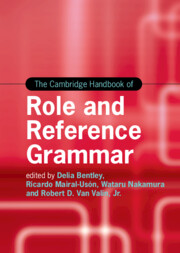Book contents
- The Cambridge Handbook of Role and Reference Grammar
- Cambridge Handbooks in Language and Linguistics
- The Cambridge Handbook of Role and Reference Grammar
- Copyright page
- Dedication
- Contents
- Figures
- Tables
- Contributors
- Pedagogical Guide to The Cambridge Handbook of Role and Reference Grammar
- Introduction
- Part One Overview
- Part Two Topics in RRG: Simple Sentences
- Part Three Topics in RRG: Complex Sentences
- Part Four Applications of RRG
- 17 Role and Reference Grammar and Diachronic Syntax
- 18 Functional Acquisition Processes in Child Language
- 19 Grammatical Aspects of Language Processing in the Brain
- 20 Formalization of RRG Syntax
- 21 Computational Implementation and Applications of Role and Reference Grammar
- Part Five Grammatical Sketches
- Index
- References
21 - Computational Implementation and Applications of Role and Reference Grammar
from Part Four - Applications of RRG
Published online by Cambridge University Press: 08 June 2023
- The Cambridge Handbook of Role and Reference Grammar
- Cambridge Handbooks in Language and Linguistics
- The Cambridge Handbook of Role and Reference Grammar
- Copyright page
- Dedication
- Contents
- Figures
- Tables
- Contributors
- Pedagogical Guide to The Cambridge Handbook of Role and Reference Grammar
- Introduction
- Part One Overview
- Part Two Topics in RRG: Simple Sentences
- Part Three Topics in RRG: Complex Sentences
- Part Four Applications of RRG
- 17 Role and Reference Grammar and Diachronic Syntax
- 18 Functional Acquisition Processes in Child Language
- 19 Grammatical Aspects of Language Processing in the Brain
- 20 Formalization of RRG Syntax
- 21 Computational Implementation and Applications of Role and Reference Grammar
- Part Five Grammatical Sketches
- Index
- References
Summary
This chapter explores the computational implementation and applications of Role and Reference Grammar (RRG). We discuss computational work which provides evidence that the RRG approach to grammar has a beneficial role to play in natural language processing (NLP) and delivers a credible and realistic linguistic model to underpin NLP applications. The computability of the model has been tested in diverse software applications. We characterize these and explain how RRG is used to underpin the linguistic component in the architecture of a number of software systems and applications. We conclude with a discussion of the contribution that RRG can provide to NLP. We discuss how the RRG model is translated into software, and some of the challenges involved. The chapter is a testimonial to how the RRG model of language can be successfully implemented in software.
Keywords
- Type
- Chapter
- Information
- The Cambridge Handbook of Role and Reference Grammar , pp. 785 - 820Publisher: Cambridge University PressPrint publication year: 2023



